Updated November 3, 2025 03:39PM
Whether you’re shopping for a snowboard online or sifting through the stacks at your local snowboard shop, it can be tough to pinpoint the right ride for you. The sheer volume of enticing options on the market can cause intense decision paralysis, side effects of which include anxiety, dry mouth, and purchasing multiple snowboards when you intended to buy just one.
To help you find the best snowboard, our selfless test crew of 31 riders strapped into 59 men’s and unisex boards at the freeride hub of Kirkwood Mountain Resort this past spring to bring you the best snowboards of 2026. Below, you’ll find the best of the best, from versatile all-mountain rippers and intermediate-friendly cruisers to buttery jib boards and freeride machines. Whether you’re looking to snag a new daily driver or completely upgrade your quiver, you can’t go wrong with these picks.
Best Snowboards: At a Glance
The Reviews: The Best Snowboards of 2026
Editors’ Choice
Jones Howler
Sizes: 152, 155, 157W, 158, 160W, 161, 163W
Genre: All-mountain/Freeride
Profile: Rocker/camber
Pros and Cons
+Jack of all trades and a master of them, too
+Trustworthy in gnarly, technical terrain
+ Freestyle pop
– Might be too much intermediates
– Doesn’t ride switch as well as twinnier shapes
The new freeride-meets-freestyle Jones Howler clocked the most perfect scores in the history of our test, earning it our coveted Editors’ Choice award twice, including for women. Designed with input from marquee Jones athletes Elena Hight and Victor De Le Rue, the directional deck has a sultry moontail and a boxy, buoyant, bulldozer-like nose that inspired confidence when we pointed it through slushy moguls and refrozen chunder. “It’s extremely hard-charging—most stable board I’ve ridden,” said one rider.
The extended sidecut and effective edge help generate stability, as does a chunder-gobbling, mid-stiff paulownia core bolstered by poppy bamboo stringers. Responsive carbon and shock-absorbing flax laminates run from the inserts to the contact points, and a Koroyd insert (a cluster of hollow straws) in the nose adds dampening while cutting weight. “It’s a working man’s board,” applauded a diehard, blue-collar Tahoe rider. “The flex inspires you to push your limits without finding the limit of the board.”
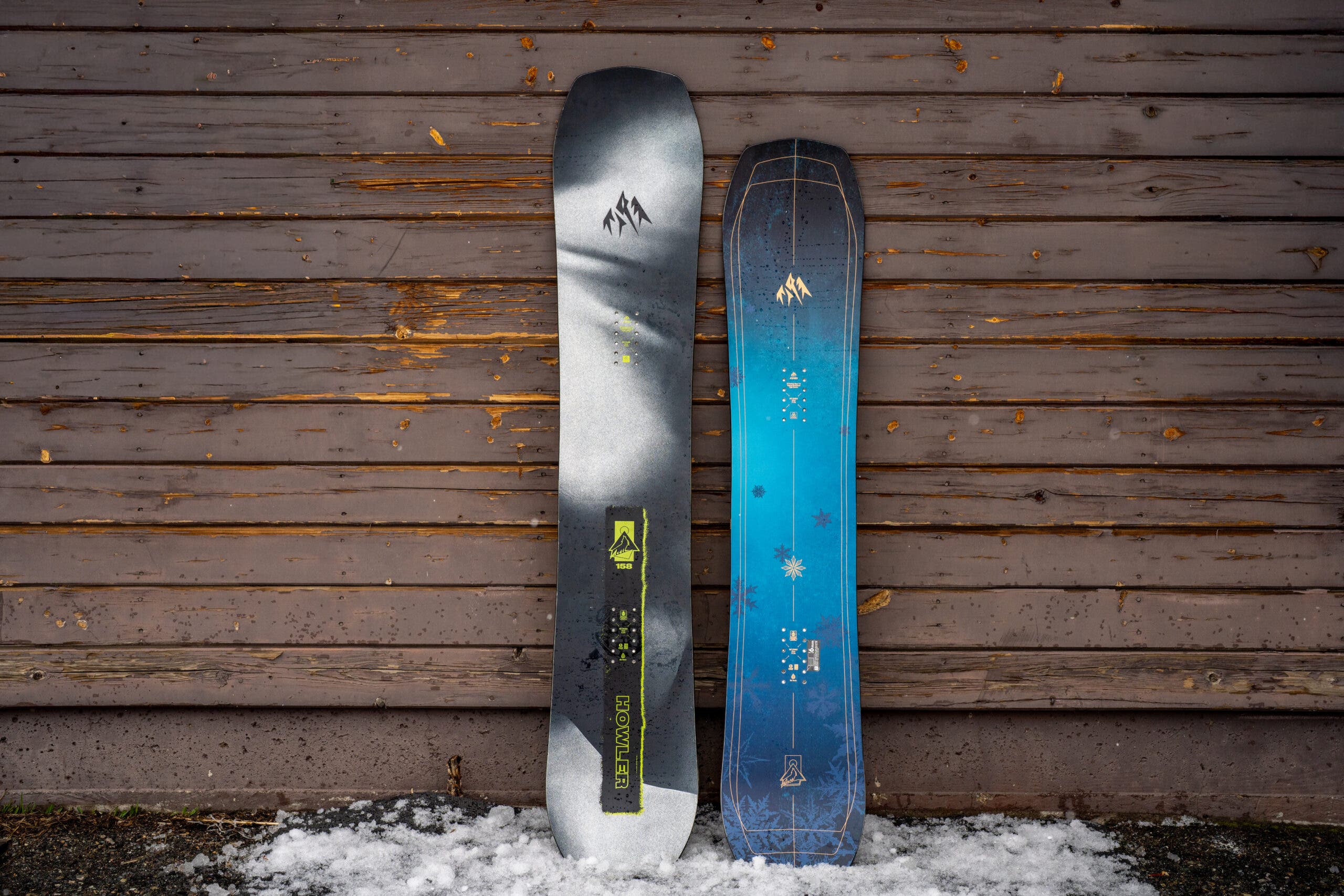
Three micro-bumps along each edge provide grip in icy hardpack. Combined with aggressive traditional camber, the 158 we tested felt as reliable as a 161 when straightlining. It rails turns like “a ginsu knife,” according to one tester, and pops “like a balloon at a six-year-old’s birthday party,” according to another.
Despite an innate proclivity for charging, testers found it surprisingly agile in glades and the park. “Probably the best all-around board for freeriders that want to jib, or jibbers that want to send freeride lines,” added a Tahoe tester. Another Tahoe rider who lives at the base of Palisades’ iconic KT-22 lift called the Howler his ideal everyday KT board–the highest possible praise. “It can pop, turn, slash, and trick. I rode it in slop and icy groomers, and it inspired confidence in both,” he reported.
Critiques were minimal. A couple of lighter, less aggressive riders suggested sizing down to better control the longer effective edge and warned that cruisy intermediate riders won’t take advantage of the Howler’s hell-raising capabilities. Another pointed out that despite the minimal taper and kicked tail, riding switch in tech terrain isn’t the Howler’s strong suit (although it lands switch in powder well given the setback). But overall, the Howler is as close as it gets to being a jack of all trades and a master of them, too. It’s freeride and freestyle, all wrapped into one, a deck that can just as easily be your daily driver or a keystone of your quiver reserved for the best days of the season.
Best All-Mountain Freestyle Snowboard
Slash ATV
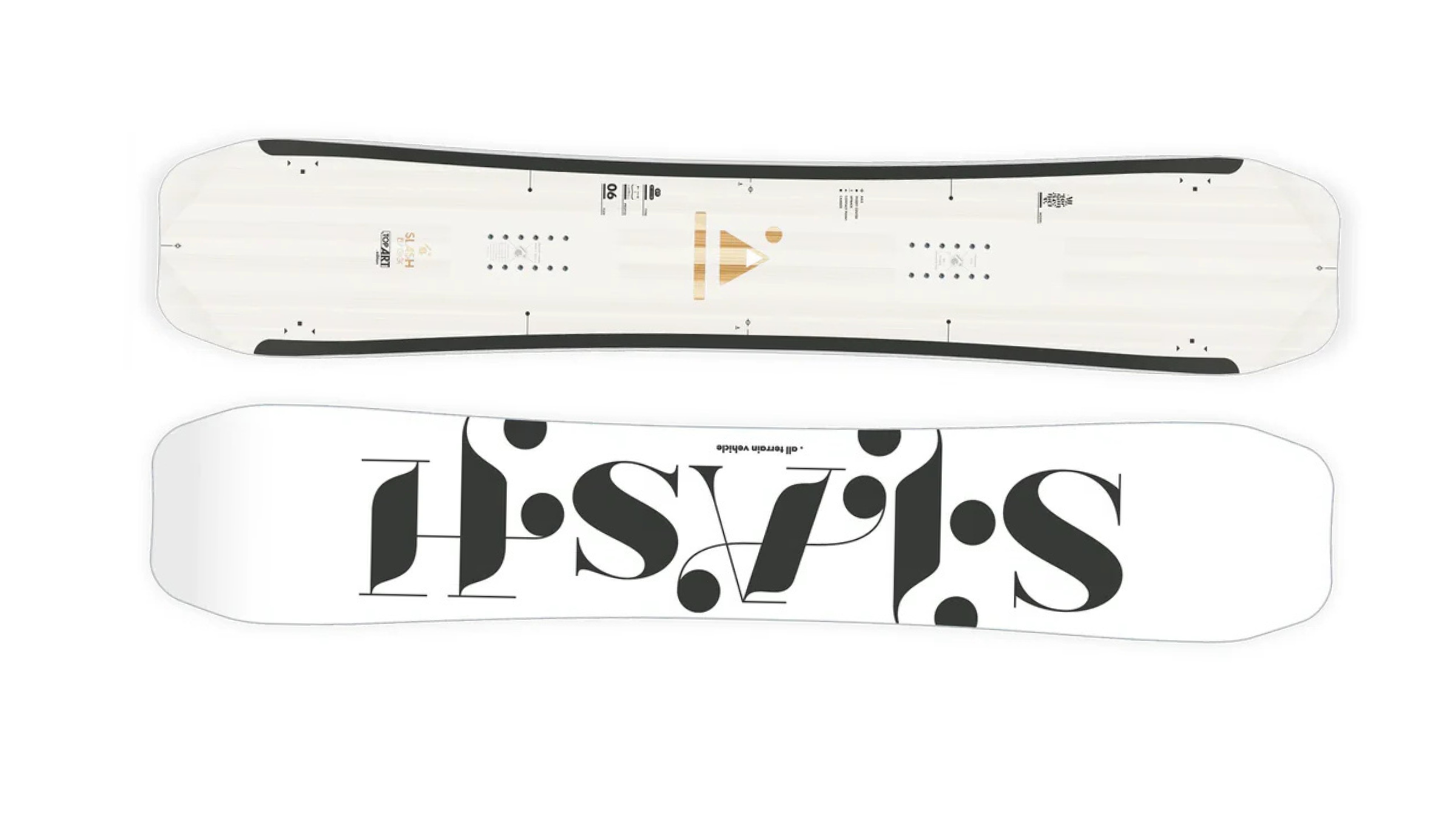
Sizes: 155, 157, 159W, 163W
Genre: All-mountain
Profile: Camber
Pros and Cons
+ Lots of pop and play
+ Versatile
+ Solid carving skills
– Better for jumps than jibs
– Short nose can be overwhelmed in deep powder
After watching Slash founder and snowboard legend Gigi Rüf style his way to a Natural Selection podium on his ATV last March, our testers were hyped to put this directional twin snowboard on the chopping block at Kirkwood. Needless to say, those high expectations were exceeded the moment our crew started snapping sky-high ollies on this all-mountain freestyle crusher.
The eye-catching shape features no taper, with a cutaway, minimally spooned nose and tail, and a hardly perceptible half-inch of setback. The resulting ride charges switch and spins on command like a roulette wheel, as the pared-down nose and tail help keep swing weight low. Ollie prowess—something all testers flagged in their reviews—comes from a generous helping of traditional camber underfoot and a medium flex. More specifically, the ATV features a thin yet snappy four-wood core (paulownia, spruce, beech, and poplar), a tried-and-true triaxial fiberglass layup, and energetic, weight-saving carbon, kevlar, and basalt trusses that run from each insert to the nose and tail.
“Great pop and tons of landing gear—this thing stomps,” said an advanced Colorado rider.
Of course, air game alone doesn’t merit adding a board to your quiver. Luckily, this snowboard is called the “ATV” for a reason. In fresh corduroy, testers found the mid-sized, single-radius sidecut lends itself to dynamic medium-arc turns, and the thinly cored waist is nimble. A subtly contoured nose and tail let the ATV quickly transition from edge to edge and dance through trees like a dinged-up druid at a forest rave. It’s snappy and reactive, and the sidecut holds an edge well while exploding out of turns and railing higher-G-force carves.
Cons were few and far between. A couple of park riders noted that the snowboard was better suited to jumpers than jibbers due to the stiffness of the nose and tail. Additionally, while the deck has a half-inch of setback, you’re going to want to bump bindings back on deeper days, as the nose can feel short and abrupt while riding powder otherwise.
Best All-Mountain Snowboard
Capita Aeronaut
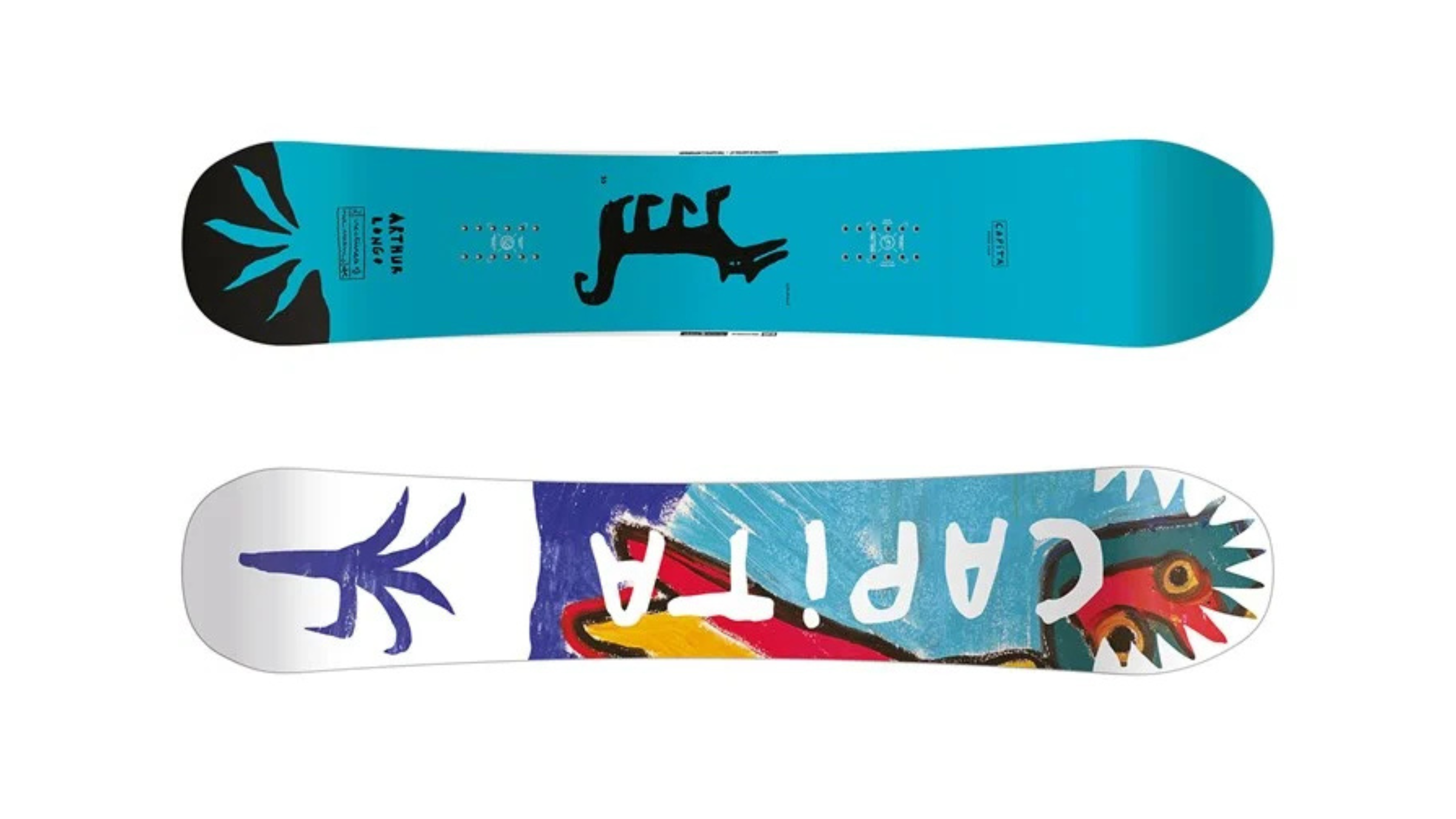
Sizes: 153, 155, 156w, 157, 158w, 159, 160w, 161, 162w cm
Genre: Resort/All-mountain
Profile: Camber
Pros and Cons
+ Intergalactic pop
+ All-mountain jack-of-all-trades
+ New wide sizes for the big boot gang
– Not super floaty
– Sometimes overwhelmed by variable chop at speed
Pop is potential energy—a board’s capacity to load, unload, and explode upwards in defiance of gravity. Capita’s aptly named Aeronaut, the pro model of French side-hit savant and style conservationist Arthur Longo, has more explosive potential energy than a ski patrol dynamite shack.
There’s no TNT stashed beneath the Aeronaut’s abstract topsheet (although testers did find the graphic, which is painted by the multi-talented Longo, dynamite). Instead, that energy comes courtesy of a mid-stiff poplar and paulownia core, eight snappy, nose-to-tail bamboo rods located just outside the inserts, and a reactive yet shock-absorbing strip running from the back inserts to the tail. If you’re popping switch or nollie—or just need some stability at speed—a pair of carbon-and-flax strips run in a “V” formation from the front inserts to the nose, too.
The standard camber profile amplifies airtime and edge hold, too. Factor in a predictable, progressive sidecut that excels at medium-sized turns, and the overall ride is so classic that riders with graying hair will rail reliable carves, regain the ollies of their youth, and weep bittersweet tears, overcome with nostalgia for the nineties. While we’re always stoked to check out innovative shapes, sometimes the classics are hard to beat.
“It’s a true resort daily driver—directional, little bit of taper, plenty of pop. I could ride this every day,” summed up longtime snowboard reviewer, former Transworld Snowboarding product editor, and connoisseur of camber Tyler Macleod.
Critiques for the Capita mainly centered around it being a jack of all trades, master of none, which is a tick in the pro column for many all-mountain riders. More specifically, a couple of riders judged the deck overwhelmed by chunder and craved more setback, taper, and float in deeper snow.
Best All-Mountain Freeride Snowboard
Capita Mercury
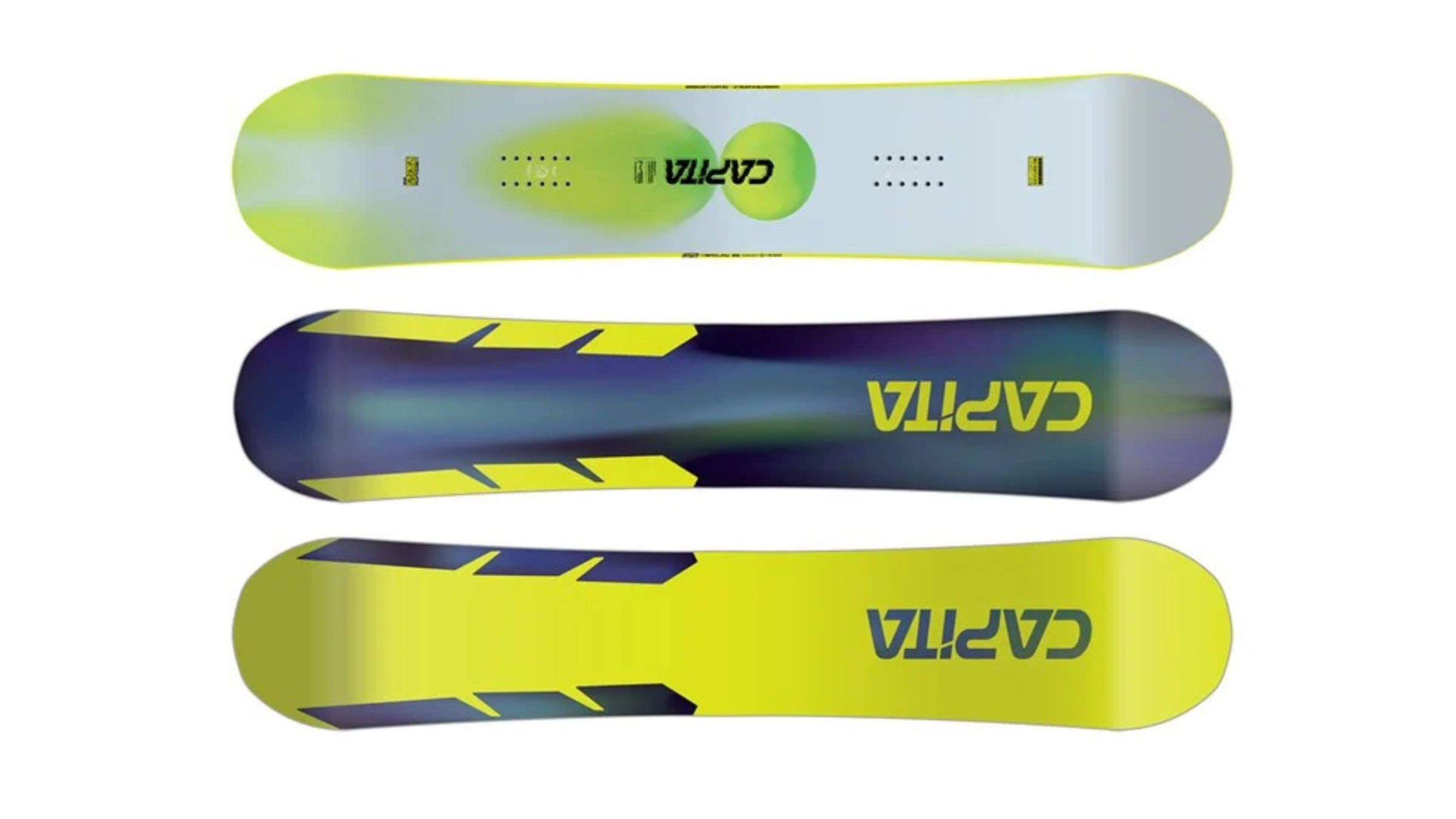
Sizes: 147, 150, 153, 155, 156W, 157, 158W, 159, 160W, 161, 162W
Genre: All-mountain/Freeride
Profile: Resort V2 Directional (positive camber dominant, running past inserts, with reverse camber beyond inserts, and kicked nose and tail)
Pros and Cons
+ Versatile
+ Good grip in hardpack and fun on rail
+ Solid pop
– Could use more backbone for chop or sketchy straightlines
– Not as floaty as more directional shapes
Capita’s take on a classic, shred-anything steed, the Mercury’s been one of our favorite snowboards for years now. This year was no different. The Mercury once again scored high marks for its versatility and rideability, making it a solid choice for all-mountain riders seeking a dependable daily driver.
The directional deck features minimal setback (half an inch) and no taper, a time-honored combination that seeks to give all-mountain riders a modicum of float and freeride stability without sacrificing switch capabilities.
The Mercury features a middle-of-the-park progressive sidecut that provides easy entry into carves, with a bump of reverse sidecut at the center of each edge that helps provide grippy turns. A Colorado tester who’s no stranger to banked slalom podiums gave it high praise: “It enjoys medium turns, riding in the trees, and carves. I would love to ride this in a banked slalom.”
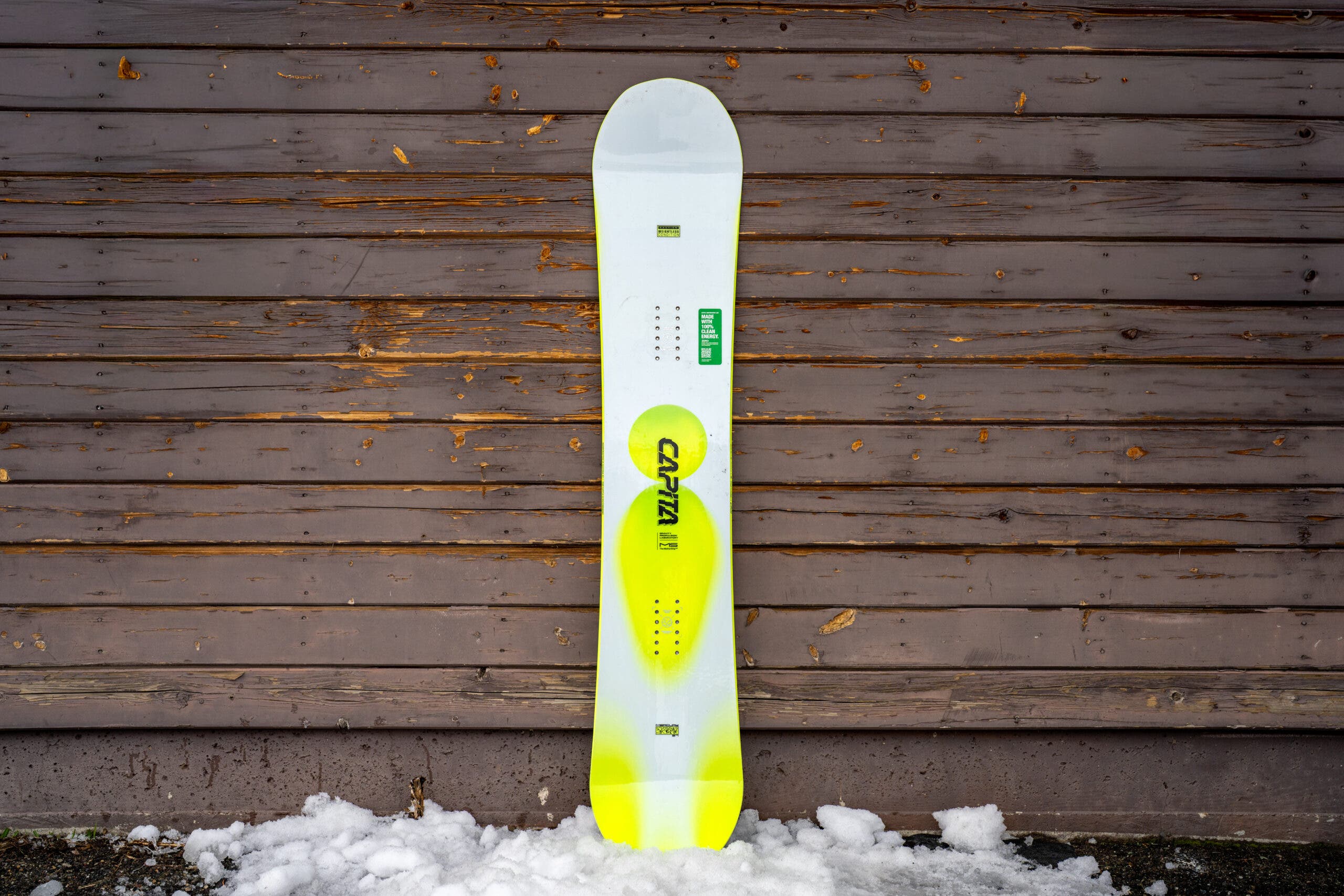
Much of the Mercury’s magic stems from its hybrid camber profile. Camber runs from the center of the board out past the inserts, and it’s what gives this board its pop. Reverse camber gently lifts the contact points, making the ride more forgiving. And the nose and tail kick up more sharply, helping the deck rail quickly from toeside to heelside and back again.
Testers did have one gripe: This snowboard might not have enough power for heavier, more aggressive riders. The construction—an interlaid poplar and paulownia core bolstered by V-shaped carbon-and-flax strips—is lightweight and balances an easy-to-ride nature with reliability. Overall, it’s friendly for intermediate-to-expert riders. However, harder-charging testers wanted a beefier backbone, especially when it came to landing bigger jumps or sending sizable cliff drops. “It’s a very likable board, but it lacks the stiffness to ride away from features at full speed,” said a Tahoe freerider. If backbone is what you’re after, check out the Mega Merc, a souped-up version that’s a touch stiffer, more responsive, lighter, and, you guessed it, much more expensive.
Best Alternative All-Mountain Snowboard
Korua Shapes Transition Finder
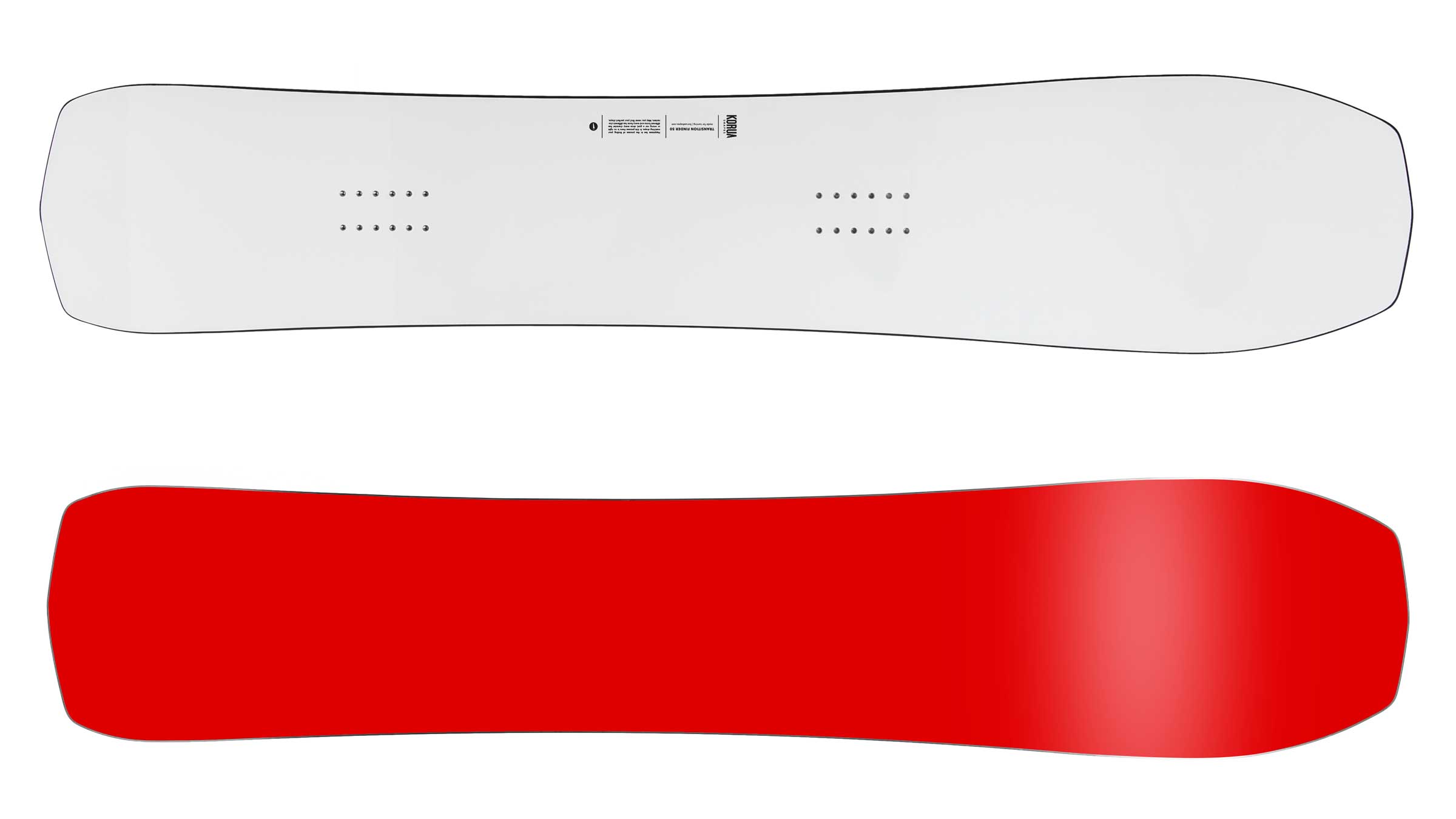
Sizes: 150, 154, 157, 160 cm
Genre: All-mountain/Backcountry Freestyle
Profile: Float Camber (rockered nose, camber underfoot)
Pros and Cons
+ Cruisy
+ Versatile
+ Affordable
– Isn’t strong switch
– Shorter-radius turns felt overwhelming on larger sizes
Korua’s cult-classic, medium-stiff Transition Finder (full review here) hasn’t been updated since the German board builder shaved down the taper to boost all-mountain freestyle and switch-riding capabilities in 2022. Our test team sends its sincerest gratitude, as we’re card-carrying members of the cult. One tester spent six weeks in Hokkaido testing the Transition Finder over the last three winters, and attests that it’s absolutely perfect as is.
“The wide, early-rise nose of the Transition Finder provided unbelievable buoyancy on hip-deep tree runs, mini-truck-sized pillow poppers, and sidecountry sojourns,” he reported. He sized down—the shape is wide, after all, with a 26-centimeter waist on the 154-centimeter length. Despite riding a shorter length, he reported: “I rode some of the deepest runs of my life on this thing, and it was never undergunned.”
The shape is deceptively agile, too. In tight corridors, you can shift your weight to the diamond tail, pivoting and piloting the Transition Finder through gaps in the glades you have no business bombing through. While the nose is pliable and surfy, the short tail is stout enough for substantial drops as well. A beefier, longer tail might be welcome if you’re sending 25-plus footers at speed, but for dropping anything up to 15 feet, he opined, the Transition Finder felt ideal.
The majority of testers who hopped on the Transition Finder during our test week felt similar sparks fly. “It pops reliably like a movie theater popcorn machine, and excels at everything from long, fast carves to tight wiggles and banked slalom slashes. Favorite board of the test—flexy, fast, fun!” commented an intermediate Sierra surfer, who loved the versatility provided by the middle-of-the-park sidecut and the dampness of Korua’s cruisy, cost-effective construction (tried-and-true biax fiberglass over an unpretentious poplar core).
That said, the Transition Finder isn’t for everyone. A heavier, aggressive freestyler found the nose flex on the floppy side for his style of all-mountain charging, and also craved better performance while riding switch.
An affordable, damp, cruisy yet capable all-mountain surfer, the Transition Finder slashes the nexus of freestyle and freeride. If you’re hoping for pow but planning to shred regardless of the conditions, this is a solid travel board, daily driver, or addition to your quiver. Between the relatively low cost and impressive versatility, it also delivers decent bang for your buck.
Best Snowboard for Intermediates
Jones Frontier 2.0

Sizes: 153, 156, 158W, 159, 161W, 162, 167W
Genre: All-mountain/Freeride
Profile: Directional rocker/camber
Pros and Cons
+ Floaty freeride shape
+ Fun and easy to ride
+ Playful freestyle chops
– Not as reliable straightlining
– Undergunned in chop
The last time Jones added a “2.0” on the end of one of their classic shapes—the Hovercraft 2.0, released in 2023—our testers were beyond impressed with the updates. The praise continues with the revamped Frontier 2.0. Now softer, more buoyant, and friendlier than ever, this redesign is a solid option if you’re an intermediate rider or simply a cruisy shredder who appreciates surfy, laidback turns and an effortless ride.
The exaggerated, elongated, rockered nose and a touch of taper (five millimeters) help the Frontier perform in powder, while three-dimensional contouring facilitates smooth and natural carving. Camber beneath your boots, a medium sidecut, and Jones’ serrated Traction Tech edges help the shape bite into piste on rail. “It lays sweet, soft trenches, and allows for nuanced wiggling underfoot,” applauded a hard-to-please Colorado tester who was surprised how much he enjoyed the cruise control of the Frontier.
An approachable combo of biaxial fiberglass and a poplar and paulownia core yields a softer, predictable flex pattern. Testers had mixed feedback on the resulting ride. Some found the Frontier 2.0 “effortless and forgiving.” Multiple harder-charging riders called it a “dad cruiser,” with a 30-year-old ripper joking he’d happily buy it—in 20 years.
Another subset of riders who might dig the Frontier 2.0? Playful park riders who enjoy riding a directional deck. “It’s a fun board for an intermediate looking to explore the mountain, and it’s also great for anyone who loves to jib, jump, and play around,” said a Wasatch rider.
Best Swallowtail Snowboard
Lib Tech Mayhem Sweet Fish
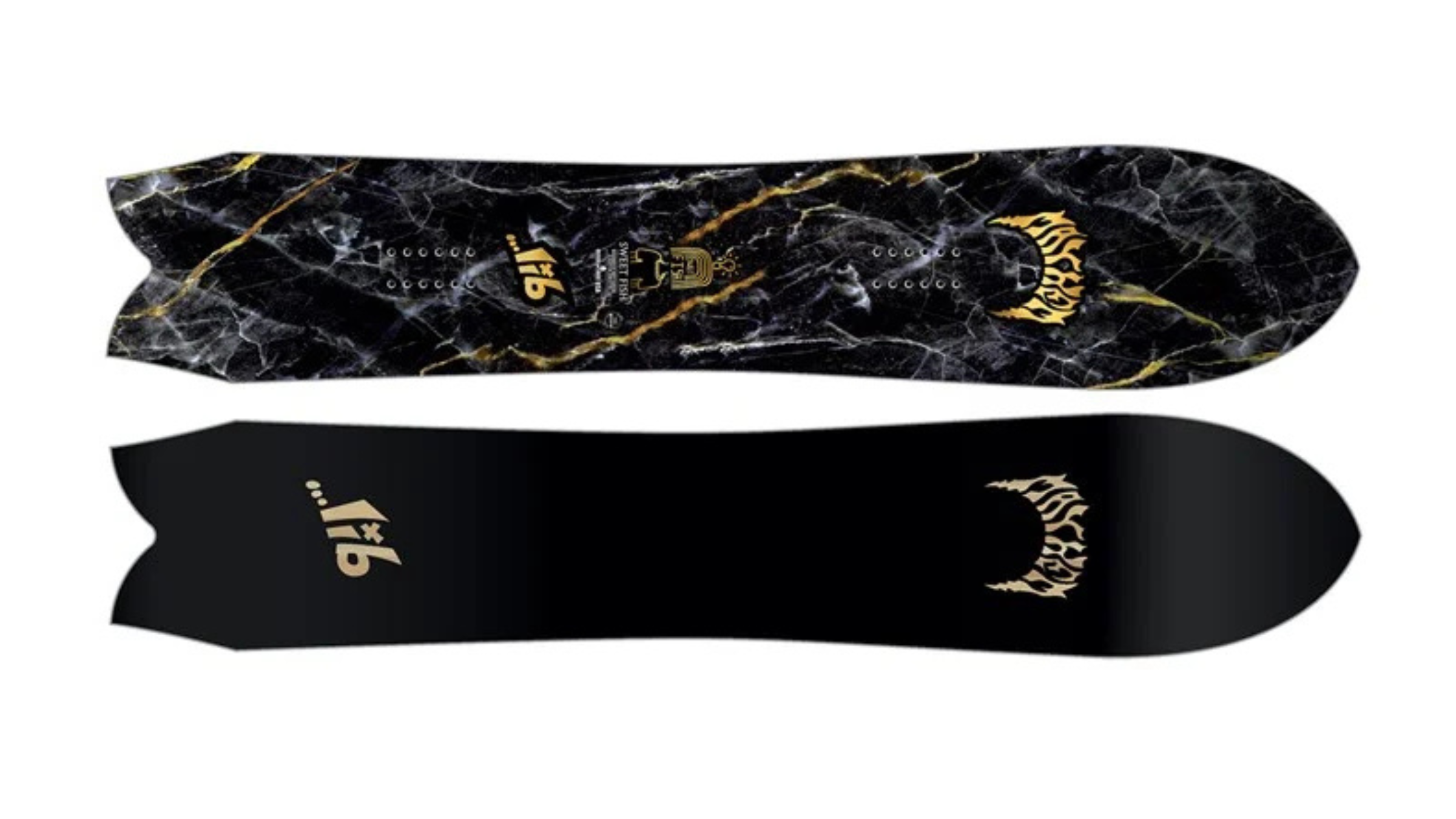
Sizes: 150, 156, 162
Genre: Powder/Alternative All-mountain
Profile: Camber
Pros and Cons
+ Super floaty in powder
+ Fun, surf-inspired shape
+ Loves to carve and rips in transition
– Big nose overwhelmed by chop
– Not ideal for steep, technical terrain
You know that feeling when two of your favorite artists collaborate on a record, and you know it’s going to be a smash hit before you press play? That’s how we felt when we heard Austen Sweetin—a PNW powderhound of the highest order— and Matt Biolos—the brains behind Lost surfboards—teamed up on the new Lib Tech Sweet Fish, a directional, cambered swallowtail that, at first glance, looks like fun. Spoiler: It is.
The outline of the Sweet Fish is outlandish: a big ole beak like a pelican, with a significant taper (just under two centimeters) back to a kinked, winged swallowtail that looks borrowed from Biolos’ critically acclaimed RNF Retro Fish surfboard. Factor in a monstrous setback of three inches, and the Sweet Fish is born for buoyancy. “Extra width gives it plenty of float in powder and slush,” said one tester. He traded waves with his wife, who was a massive fan of the Fish, too. “I didn’t ride any terrain this board didn’t chew up and spit out,” she reported.
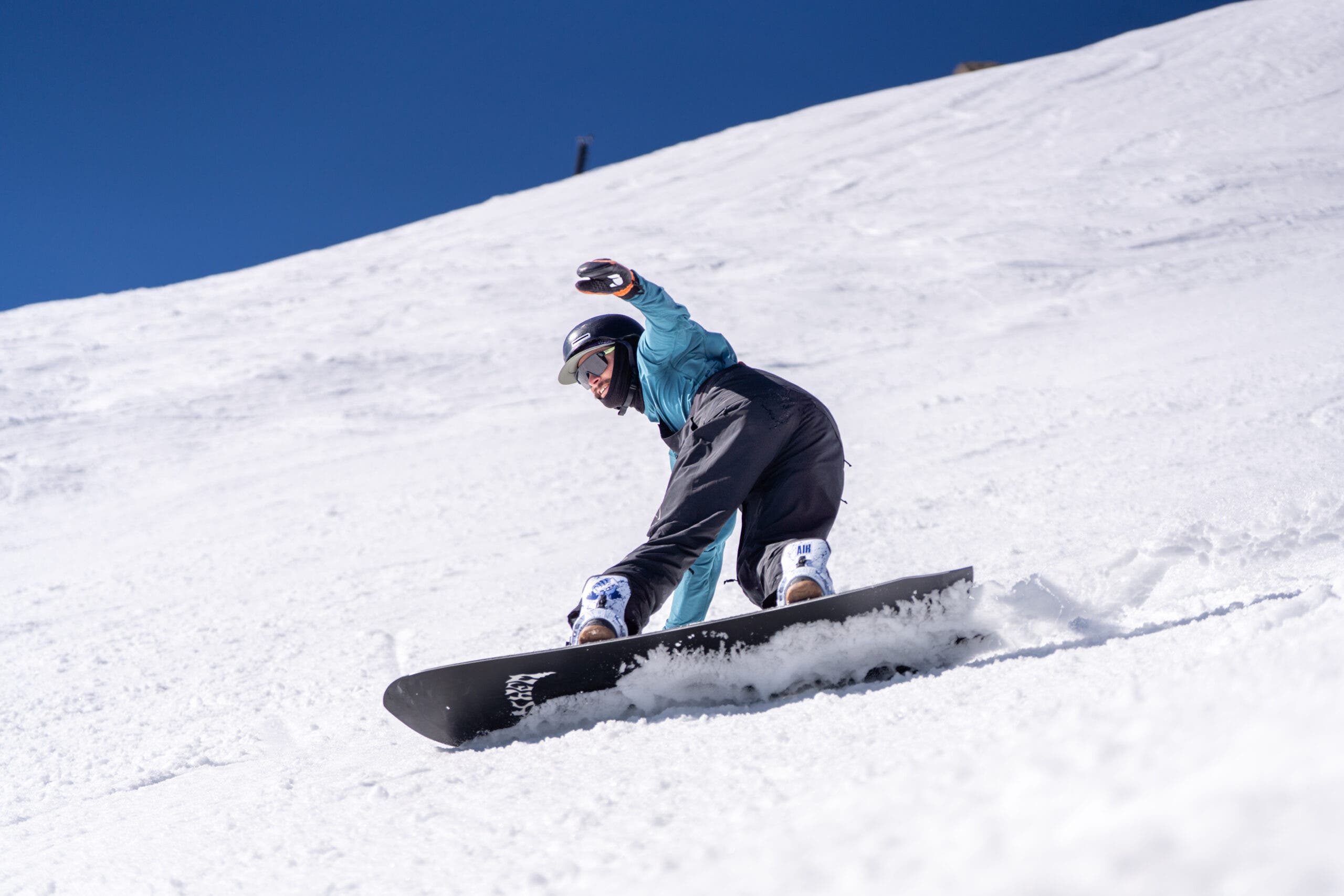
Ostensibly, the shape might seem to prioritize powder, but a traditional camber profile, kicked tail, and medium-stiff aspen and paulownia core make the Sweet Fish a corduroy predator. It’s quick, directional, and loves to carve. Testers had the most fun riding the Sweet Fish in natural and man-made transitions, from melted-out mini pipes and head-high snake runs to wave-like windlips.
While a few surfier testers would happily ride the Lib Tech daily, for others, it remained a quiver shape, as variable snow and tech terrain could make this fish feel out of water. A freerider, for instance, was hesitant to take it into the steeps. “Felt great throwing slush around and digging in carves, but it kinda fell apart on fast, steep, choppy stuff,” said a Tahoe-based snowboard coach.
Best Freeride Snowboard
K2 Sky Pilot
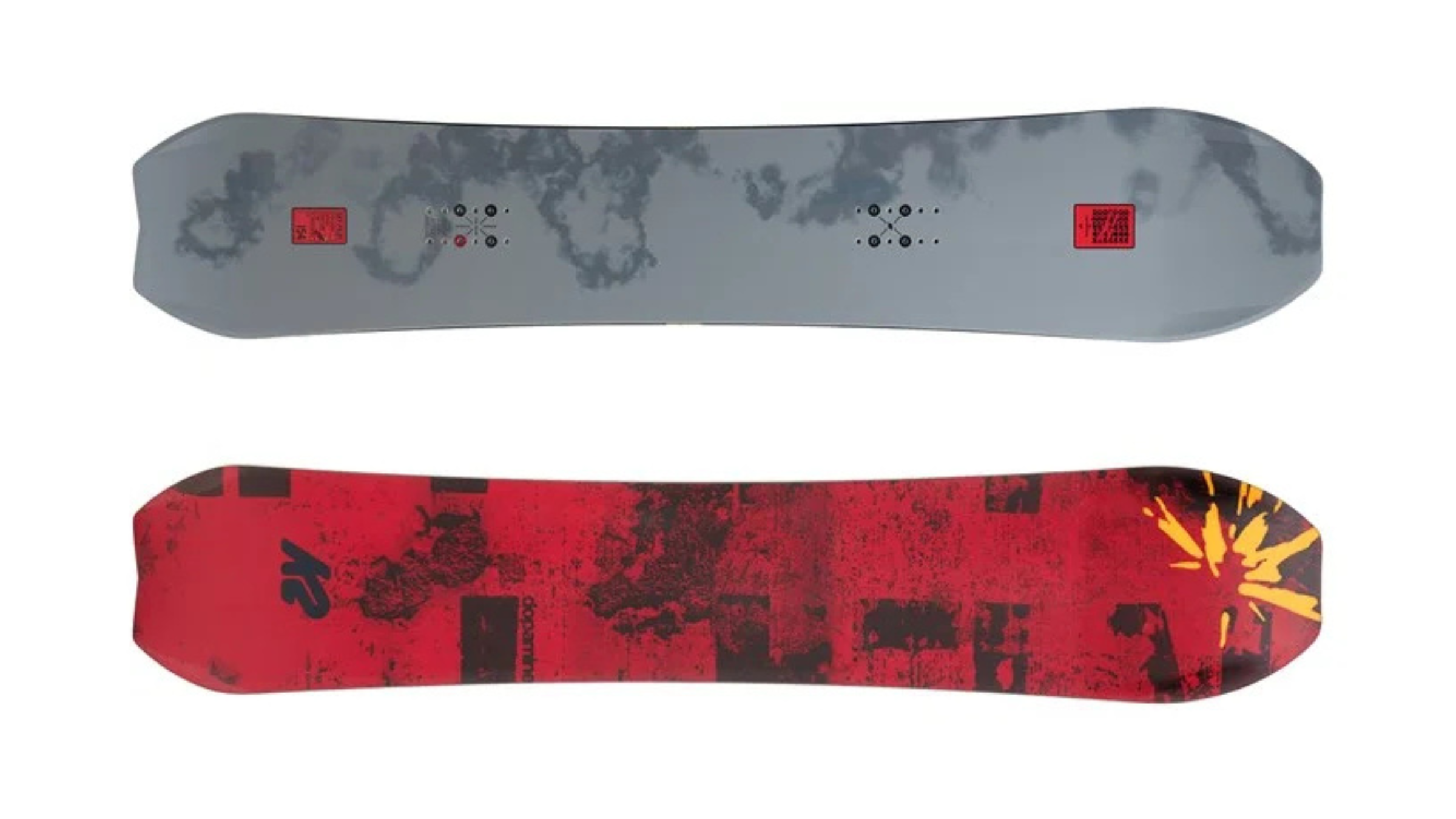
Sizes: 148, 151, 154, 157, 160, 163
Genre: Freeride/Powder/Backcountry Freestyle
Profile: Directional camber
Pros and Cons
+ Nimble and floaty
+ Excellent pop and landing gear from the stout tail
+ Trustworthy without being overly stiff
– Requires some speed/power to butter well
K2’s new Sky Pilot could’ve been called the Autopilot—this freeride charger drops the landing gear even if you’re asleep at the joystick. A collaboration between board builder J. Stone and Olympic gold medalist-turned-backcountry beast Sage Kotsenburg, the Sky Pilot is a slightly volume-shifted directional snowboard with a fat, squared-off nose and a notched tail. It sports a rocker-camber-rocker profile and a centimeter of taper, all of which boost float in powder.
According to a Tahoe tester who rode the Sky Pilot all spring long, the board pivots like a pro in the deep stuff. In choppier conditions, the Antidote felt confidence-inspiring without being domineering. “It feels like an extension of my boots and bindings, no matter the conditions,” he reported.
The moniker “Sky Pilot” is apt: the board has a stellar landing gear that comes from bamboo stringers and carbon beams stiffening up a squat tail. The carbon beams run parallel from the tail, just outside the inserts, all the way to the front of the deck before veering off to the nose contact points, and gives the Sky Pilot a bit more backseat backbone than expected given the six out of ten flex rating. And when it’s time to lay a trench, the Sky Pilot is no slouch. “It digs a fast edge and holds with maximum edge control,” commented that Wasatch rider.
Numeric flex ratings aside, the tail has snap for ollies and wants to pop off sidehits, launch cat tracks, and drop cliffs. “Even when I bit off features that were above my pay grade, the stout tail helped me ride it out,” commented that first Tahoe rider. “It challenged every condition I could throw at it, and rewards hard-charging riders who like airtime along the way,” chimed in another Tahoe freerider, appreciating that tail when navigating more technical and steep terrain.
We had minimal dings for the Sky Pilot. Common misgivings were that the nose was a bit too big and beefy for easy butters, and the Sky Pilot was not comfortable on jib laps through the park. But let’s be real: This isn’t a jib board, and it butters beautifully at speed—so just hit the gas and let ‘er rip.
Best Park/Jib Snowboard
Public Disorder

Sizes: 149, 152, 155
Genre: Park/Jib/All-mountain
Profile: Micro Camber
Pros and Cons
+ Butters, pops, and presses with ease
+ Affordable
+ Made by a boutique brand
– Lacks stiffness for heavier/chargier riders
– Limited size run
If the thought of spending over $500 on a board you’re just going to thrash into rails, park features, and maybe even concrete in the streets makes you sick to your stomach, Public has the antacid right here: the Disorder. The pro model of Public founder and patron saint of Midwest steel, Joe Sexton, the Disorder is affordably priced, minimally cambered for a balance between pop, grip, and ride feel, and on the softer side for playful jibbing.
Public’s M.O. is generally no-frills, keeping their snowboards intentionally clean and simple under the hood. The twin-shaped Disorder features easy-riding biaxial fiberglass, a classic poplar core, and a nose-to-tail carbon stringer for ollie power while keeping the torsional axis loose and free.
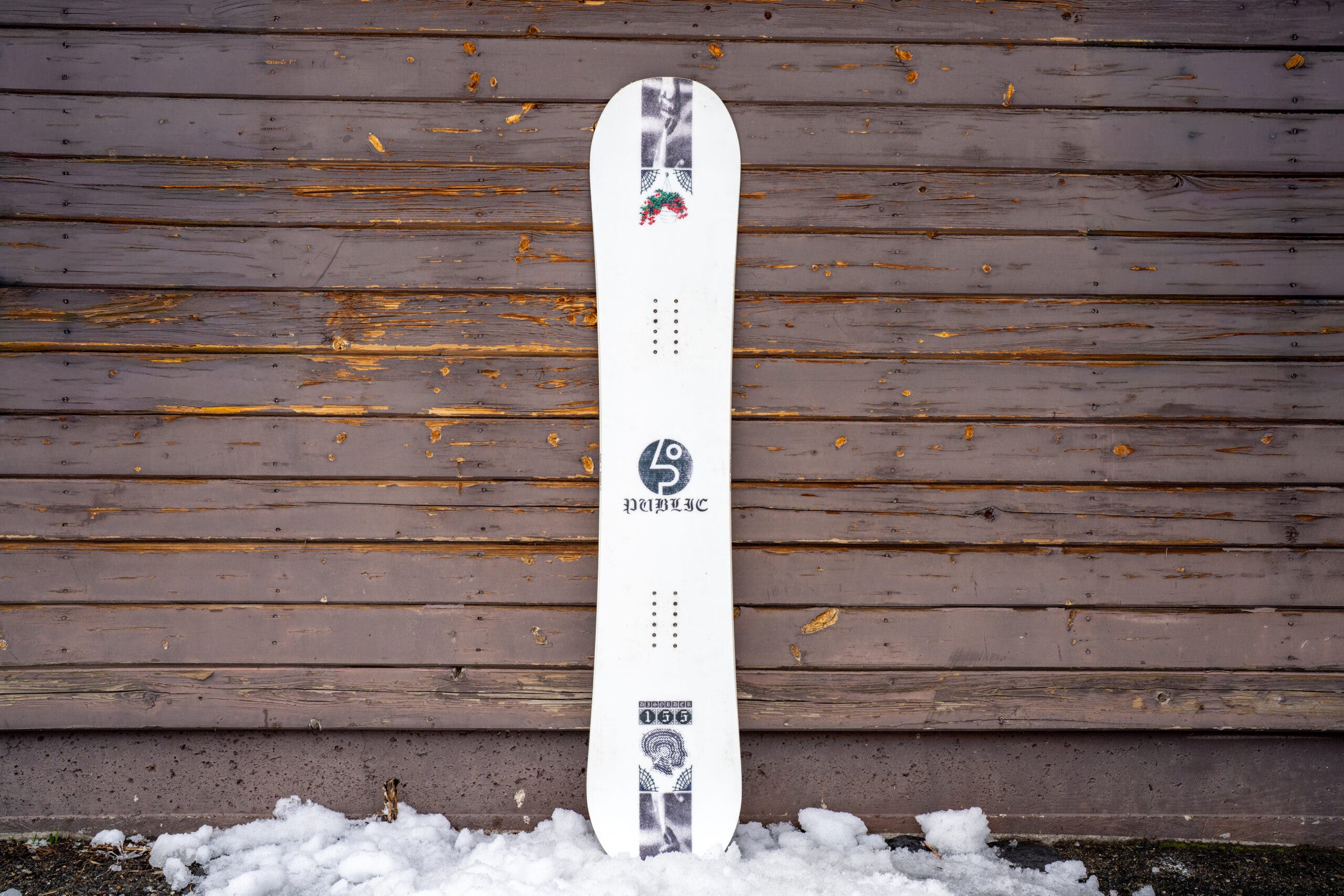
“I’d happily ride this as my everyday park board—awesome for any park rider,” commented a South Lake Tahoe jibber. “It’s soft and fun to spin and butter and press, and it destroys side hits, rails, and banks,” agreed a sponsored Colorado rider who would reserve the Disorder for jib laps and park sessions.
Other riders, namely lighter or less hard-charging ones, were stoked to explore beyond the park. “Super duper playful jib board, but not too much of a noodle—you can definitely play with most of the mountain,” wrote one, although he did crave more landing gear for cliff drops.
Another Tahoe rider who called this his dream spring park board for cruising sidehits and jibs with friends summed it up: “I love how Public keeps it simple with the graphic and shape. It’s a no-nonsense board that’s just good for snowboarding.”
Best Lightweight Snowboard
Korua Shapes Otto Plus
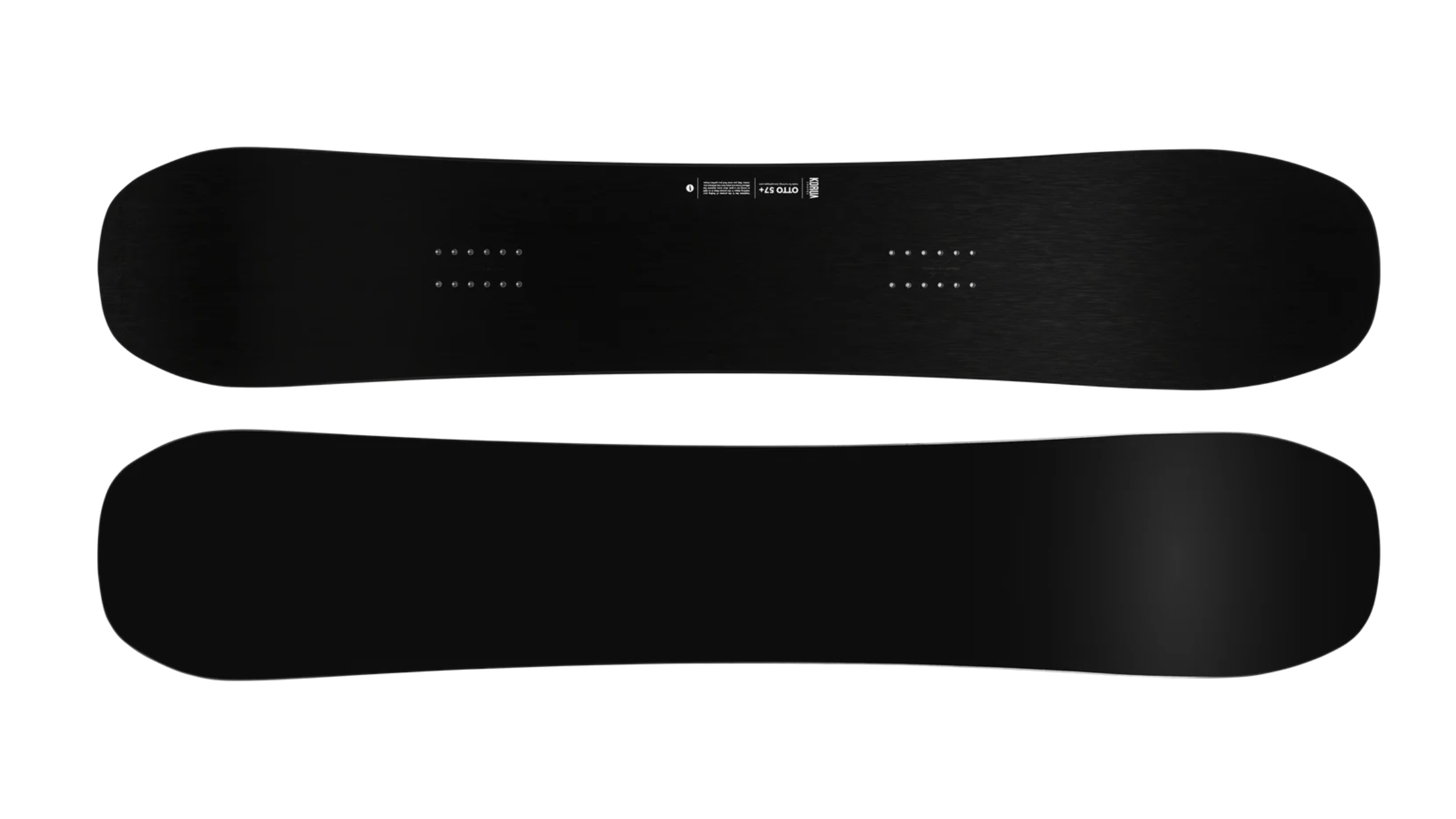
Sizes: 157, 161
Genre: All-mountain/Freestyle
Profile: Float camber (rockered nose, cambered bulk of the board)
Pros and Cons
+ Ultralight and fast construction
+ Responsive
+ Fun carving and freestyle capabilities
– Minimal size run
– Overwhelmed by chop or chunky landings
This souped-up version of Korua’s popular Otto snowboard features carbon laminates, lighter space-age cores and topsheets, and a Perlatec graphite base for a faster ride. Not only does this Plus build slash weight compared to Korua’s standard build (recognizable by the Euro board builder’s iconic white topsheets and red bases), it’s also more responsive.
The tech might be futuristic, but the shape is classic. We’re talking a rounded nose and tail, camber underfoot, no taper, and a rockered nose. An all-mountain Wasatch rider was enamored from the first time his chest grazed corduroy while euro-carving on the Otto Plus. “I love this board. It’s extremely fun, and there’s an aggressive feel that makes me feel stable. It loves to carve a groomer and jumps well, too.”
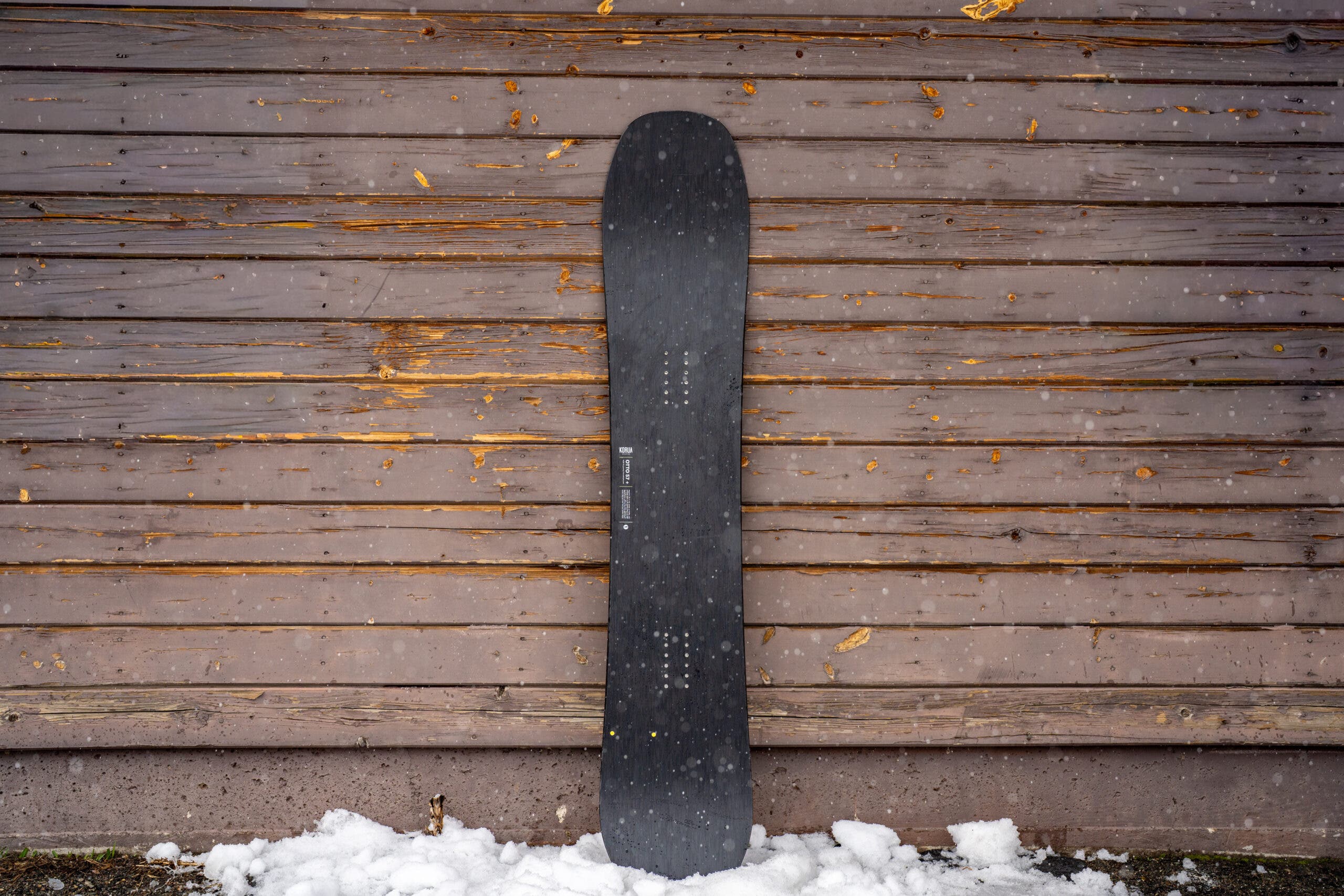
Testers felt the carbon construction helped the Otto Plus be quick edge to edge and snappy out of turns. This, despite a generous waist width that helps the Korua float on deeper days and allows all-mountain riders to size down a smidge. A Tahoe freestyler was impressed by both the pop and landing gear after pointing the Otto Plus through park laps and side hits. “I went huge off a natural step-up and landed switch just fine,” he reported.
While Korua markets this as a “freestyle-focused carving board,” even our freeride contingent was down with the Otto Plus. One freerider called it “a high-performance deck for riders who enjoy the finer things in life—and in their snowboards.” He loved the lightning-fast reactivity of the carbon build, and the razor-like carving prowess provided by medium sidecut and reliable camber underfoot. “The transfer of energy is amazing,” he said, although he was less stoked hucking into firm landings or straightlining through chop, as the carbon build’s rebound isn’t as damp as Korua’s standard constructions.
Other concerns? Beginners and less aggressive intermediates should steer clear—this is overkill for you, both in terms of stiffness and price. Also, one rider pointed out that Korua’s Plus carbon construction isn’t as bombproof as the standard fiberglass builds, and he would be sad to scuff up such a work of art.
Best Backcountry-Freestyle Snowboard
Nitro Alternator

Sizes: 154, 157, 160, 162w cm
Genre: All-mountain/Backcountry freestyle
Profile: Trüe Camber
Pros and Cons
+ Jack of all trades
+ Lightweight
+ Responsive
+ Reasonably priced
– Not forgiving for less experienced riders
– Not as much float as tapered, wider shapes
The Nitro Alternator is a no-bullshit quiver-killer that earned our coveted Editor’s Choice award last season (read our full 2025 review here). The ride remains unchanged for 2026, although ladies and smaller riders will be stoked to see a women’s version drop this year.
The Alternator can rip groomers, charge steeps, drop cliffs, and straightline sketchy runouts like it’s trying to break the sound barrier. Snowboard purists will appreciate the Alternator’s frills-free traditional camber profile. “It holds a strong edge, and loads behind the back foot for explosive pop,” commented a freestyle-forward rider and longtime board tester.
After getting the Alternator airborne during our test week and beyond, a lifelong board nerd praised the stability provided by the mid-stiff, high-grade poplar core, reinforced by nose-to-tail carbon stringers. “No fear of looping out or going over the bars here,” he reported. “In fact, [the Alternator] saved my ass a few times when I thought I was about to go over the nose.”
The classically directional deck sports subtle setback and minimal taper, as well as an early rise nose and a kicked tail. While the Alternator wasn’t the best in test when it came to float in powder or switch stomping and ripping ability, the design provides what testers agreed is a solid balance between the two. Testers also loved the Alternator’s carving prowess, which comes courtesy of Nitro’s Dual Degressive sidecut—a smaller-radius sidecut between the bindings that’s bookended by larger-radius sidecuts at the nose and tail.
Testers noted there are more forgiving boards out there for intermediate riders, and resort rippers concerned with technical jibbing should look elsewhere. They also reported that the standard-cambered Alternator doesn’t plane as well as wider, rockered shapes in slow, low-angle powder, so if you’re looking for a powder stick and between sizes, they recommend sizing up. At speed in the steeps, though, it’s a dream.
How to Choose the Best Snowboard
Shopping for snowboards is like dropping a cliff: It’s equal parts exciting and nerve-wracking. But if you do your homework before you send, chances are you’ll ride out just fine. Here are a few tips to help you stick your landing:
Ride as Many Boards as Possible
Demo boards from your local shop or at resort demo days, swap with your friends, and do whatever it takes to ride as many boards as you can. Whether you’re an old head or relatively new to the game, testing a diverse range of boards will expand your snowboard lexicon. You can read reviews of the best snowboards for women all day long, but nothing informs your decision-making like time on snow. One word of advice: Complete newbies should learn to turn properly on a board they’re comfortable with before going on demo sprees.
Shop by Riding Style
Here are the three most common snowboard styles:
- Freestyle Boards: Freestyle, or park, boards are on the shorter side, which makes them easier to spin. They’re either true twins, meaning they’re symmetrical from nose to tail, facilitating landing and riding switch, or directional twins, symmetrical in shape but not in flex pattern or profile, or vice versa.
- Freeride Boards: Freeride boards are designed for speed and stability when charging groomers, riding off-piste, and ripping backcountry conditions. They’re usually directional (the nose and tail are defined) and tapered (the nose is wider than the tail). Directional shapes float and carve well, but riding switch isn’t a cakewalk. Most freeride boards are on the stiffer side, supplying stability for big mountain charging.
- All-Mountain Boards: All-mountain shapes blend the freestyle elements of park boards and the big-mountain chops of freeride decks. They can ride switch through the park one lap and bomb a hike-to chute the next. If you’re unsure of where to start or you only have a budget for one board, go with a versatile all-mountain board.
Consider Profile
Profile refers to the curvature that’s visible when you lay a board flat on the ground and look at it from the side. It is a critical element of board design, as it dictates how and where a board interacts with snow. There are two primary profiles to be familiar with: camber and rocker.
- Camber is the time-honored, traditional profile that looks like an upside-down U when laid flat. The board will touch the ground near the nose and tail, but the center will be raised off of the ground. This curvature supplies drive, stability, and edge hold, allowing riders to flex into the deck and dig into the snow. It’s also a principle ingredient in pop production—if you like to send ollies to the moon or carve aggressively on groomers, camber is your launch pad.
- Rocker is reversed camber. Lay a rockered board flat, and it’s shaped like a subtle U. You’ll find a single low point in the center of the board while the nose and tail float off the ground. Rocker provides a fun, skate-like ride. It’s easy to turn, and it enables you to weight your back foot and float through deep powder. However, it’s not as reliable in technical steeps, on icy hardpack, or on high-speed straight lines.
- Hybrid profiles mix rocker and camber. These combos usually attempt to blend the skate-like, buoyant, easy-turning aspects of rocker with the pop, stability, and edge-hold of camber.
Sizing Tips
Sizing a board can be just as tricky as picking one in the first place. Sizing depends on a number of factors, both in terms of the board itself and the rider who’s rocking it. One outdated sizing method: comparing board length to rider height, which doesn’t account for weight or board width. Instead, focus on these considerations.
- Rider Weight: Weight enables a rider to flex a board and engage its camber profile.
- Skill Level: If you’re a beginner, look at softer, forgiving shapes—and if you’re between sizes, err shorter. A smaller board is going to be much easier to turn and better suited for learning. If you’re an intermediate, size in the middle of your weight range and consider slightly stiffer all-mountain shapes—these boards will allow you to progress and build upon the skills you developed on a softer, shorter shape. If you’re an advanced rider, your board sizing depends more on riding style.
- Riding Style: As we mentioned earlier, different boards are meant for different objectives. That said, most people can’t afford a full quiver. So, when in doubt, go with an all-mountain shape and size to get the most versatility for your buck. That 158 can still hit jumps and rails, and on powder days, you can set back your bindings for more float.
- Snow Conditions: Powder-specific boards are usually longer, wider, or both, providing more surface area and float in deep snow.
- Boots: If you have large boots, particularly in relation to your height and weight, you may need to consider a mid-wide or wide board. The last thing you want is toe or heel drag, which will happen on a board that’s too narrow for your boot length.
- Volume-Shifted Shapes: Some boards, referred to as volume-shifted shapes, are meant to be ridden shorter than traditional snowboards. Volume-shifted shapes condense the surface area and float of a longer shape into a more maneuverable package. Usually, a brand will supply sizing recommendations for volume-shifted shapes. Once you figure out your standard board sizing, you’ll be able to size volume-shifted shapes accordingly.
- Demo Multiple Sizes: Again, the best way to develop your understanding of snowboard sizes is to keep demoing boards. Don’t just demo different boards from different brands, either—if possible, demo the same board, from the same brand, in slightly different sizes, and test them in varied conditions.
Unisex, Women’s, and Men’s Snowboards
Women’s snowboards are generally smaller and more flexible compared to men’s snowboards. Other than those key attributes, the biggest difference between men’s snowboards and women’s snowboards often comes down to graphics, which might impact the aesthetic of your kit, but not the way a board performs on the hill. But don’t let gender dictate what boards you can and can’t ride. Many of our male and female snowboard testers ride unisex boards, which are becoming increasingly popular as brands turn away from largely unhelpful gender constraints. Instead, focus on factors like flex, board length, recommended rider weights, board width (especially regarding your boot size), and other riding features.

How We Test the Best Snowboards
- Number of testers: 31
- Snowboards tested: 59
- Brands represented: 25
- Average board score: 72 percent (Up from 68 percent last year). For reference, the average board scored a 5.08 out of 7, which, based on our rubric, translates to a “good” board that testers would be happy to add to their quiver.
- Highest board score: 93 percent (Jones Howler)
- Review forms submitted: 506+
- Biggest spin of the test: 720
- Tester-on-tester collisions: 1
- Cases of Fat Tire remaining at the end of the test: 0
Our home for this year’s snowboard test was dream destination Kirkwood Mountain Resort. Located just south of Lake Tahoe, Kirkwood is 45 minutes away from Stateline, Nevada, and an hour and a half from the Reno-Tahoe International Airport—just far enough away from the closest hubs that it can be much less crowded than many more easily accessed Tahoe shred destinations, and that’s just fine with us. Not only do our testers hate lift lines, but racking up maximum vert is mission-critical for testing the best women’s snowboards.
Our shredquarters for the week was steps away from Chair 10, also known as “The Wall,” a notorious lift that’s an unbeatable gateway to cliffs, steeps, and technical terrain. No joke, this lift accesses some of the best freeride terrain in the Lower 48, although the most gnarly face, The Cirque, is closed to the public (sadly, that does include our test team, though our freeride testers were salivating at the thought of getting a chance to ride this legendary terrain). The Cirque does, however, open for freeride competitions, and Kirkwood hosted Freeride World Tour qualifying events, Junior Freeride Championships, and even a Natural Selection Tour duel in the zone last season.
A snowball’s throw from The Wall is Chair 6, also known as “Cornice Express,” a high-speed chair that gives way to more freeride terrain, sidehit-laden gullies, steep groomers, flowy trails, terrain parks, and mogul fields. While we explored the entire resort, most of our time was spent lapping Chair 6. It allowed our test team to stack vert and test snowboards efficiently. Last but not least, we spent a solid chunk of time in Kirkwood’s terrain parks, which, aside from our crew, were virtually empty mid-week, despite sunny, slushy conditions (primo for park laps!). To be honest, we’ve tested snowboards at countless resorts over the years, and it’s hard to think of a better proving ground than Kirkwood.
We had 13 women on the testing roster this year, enough to handle 47 unisex and women’s snowboards submitted by brands big and boutique alike. The vast majority of our test team consisted of riders local to the Sierra, ranging from intermediate to expert—a critical mix to assess which boards are best for each specific skill level.
After hammering two or three laps on a board—occasionally more if the deck deserved it—testers returned to shredquarters to fill out comprehensive review forms. We scored boards on overall performance, responsiveness, turning ability, pop, and performance at speed. We also asked them a handful of qualitative questions, including if they’d spend their hard-earned cash on each board. Then, we grabbed a drill or screwdriver, found a new steed, swapped bindings, and hit the slopes. Rip, review, wrench, repeat.
We also ran extended testing throughout the rest of the season, seeking to put higher-scoring gear through as many conditions and scenarios as possible. Testers took top-performing splits, solids, boots, and bindings home for long-term analysis, riding until the snow melted and the lifts stopped churning at their local hills (Palisades and Mammoth were cranking through May and June, respectively).
Then, I sorted through over 506 feedback forms—the most review forms we’ve ever collected—before identifying the top picks and writing these reviews. Lastly, I compared our top picks from this year’s test with top picks from last year’s test. That enables us to include a few carryover favorites from last year in this guide to fill any gaps in our coverage, because, hey, if it ain’t broke
Meet Our Testers
Drew Zieff is a Tahoe-based freelance writer and a lifelong snowboarder. In addition to directing Outside’s snowboard and splitboard gear tests—a role he’s handled since 2016—he directs Backcountry Magazine’s splitboard test and nerds out on snowboard gear and travel for REI, Gear Junkie, Gear Patrol, and Whitelines, among others. He spends his winters testing snowboard and splitboard gear in his backyard backcountry zones or up at Palisades Tahoe, as well as chasing stories and storms to snowboard meccas like Japan and Norway. His summers? They’re mainly spent at his desk, sifting through review forms and spec sheets, compiling our snowboard reviews—although he occasionally disappears in his custom-built 2006 Chevy Express for a few days when there’s swell on the coast.
The only thing more eclectic than Chris Cloyd’s riding style is his resume. A former touring musician, former personal trainer, and still-holding-on endurance athlete who lives in June Lake, CA, Chris Cloyd spends his winters splitboard guiding, teaching AIARE courses, and handling radministrative duties for Blackbird Mountain Guides. In his free time, you can find him crushing couloirs deep in the Eastern Sierras or putting solid boards through their paces at June Mountain and Mammoth. A fan of strong coffee and heavy metal who often combines the two on his way to shred, Cloyd is not remotely gentle on his gear—he lives to thrash.
A longtime member of the Outside magazine test team and an indiscriminate all-mountain charger, John Lauer is a snowboard buyer and boot fitter for Truckee’s own Tahoe Sports Hub. When the consummate gear nerd isn’t slanging snowboards, you can find him sending cliffs at Palisades, dusting off the tricks of his youth in the terrain park, splitboarding in his backyard, or chastising his very bad but very cute dog, Wendy.


